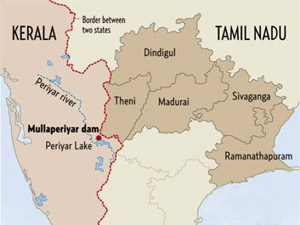Geography
Mullaperiyar Dam
- 17 Mar 2021
- 5 min read
Why in News
Recently, the Supreme Court (SC) has ordered the Mullaperiyar Dam Supervisory Committee to issue directions on issues concerning the dam's safety.
- The SC constituted a permanent Supervisory Committee in 2014 to oversee all the issues concerning Mullaperiyar dam. The dam is a source of friction between Tamil Nadu and Kerala.
Key Points
- Background:
- A petition was filed by a resident of Idukki district of Kerala to lower the water level of Mullaperiyar dam to 130 feet saying there is a danger of earthquakes and floods in the area as monsoon progresses in the State.
- The petitioner contended that the Supervisory Committee had become “lethargical” about the safety inspection and survey of the dam.
- It had delegated its duties to a sub-committee of local officials.
- The instrumentation scheme, safety mechanism, etc, have not been finalised for the past six years.
- Tamil Nadu’s Stand:
- Blamed Kerala for delaying the finalisation of the rule curve for the dam.
- Rule curve in a dam decides the fluctuating storage levels in a reservoir. The gate opening schedule of a dam is based on the rule curve.
- It is part of the “core safety” mechanism in a dam.
- The rule curve level is fixed to avoid emergency opening of dam shutters in case of a flood-like situation. It helps in controlling the water level in the dam during peak monsoon.
- Kerala has made consistent efforts to obstruct Tamil Nadu from operating the dam.
- Tamil Nadu is not able to access data which is in Kerala’s terrain. There is no road built, the power supply has not been restored although Tamil Nadu has paid for it.
- Blamed Kerala for delaying the finalisation of the rule curve for the dam.
- Kerala’s Stand:
- Accused Tamil Nadu of adopting an “obsolete” gate operation schedule dating back to 1939.
- SC’s Ruling:
- Tamil Nadu’s Chief Secretary shall be “personally responsible” and “appropriate action” will be taken on failure to give information on the rule curve for Mullaperiyar dam to the SC -appointed Supervisory Committee.
- Directed the Supervisory Committee to issue directions or take steps to address the three core safety issues and submit a compliance report in four weeks.
- Core Issues:
- Monitoring and performance of the instrumentation of the dam.
- Finalising the rule curve.
- Fixing the gate operating schedule.
- Reason:
- The three core issues are directly concerned with the safety of the dam and will have a cascading effect on persons residing in the nearby areas.
- Core Issues:
Mullaperiyar Dam
- The Mullaperiyar, a 123-year-old dam, is located on the confluence of the Mullayar and Periyar rivers in Kerala’s Idukki district.
- The dam stands at the height of 53.66 metres and 365.85 metres in length.
- It is operated and maintained by the Tamil Nadu for meeting the drinking water and irrigation requirements of five of its southern districts.
- According to a 999-year lease agreement made during the British rule the operational rights were handed over to Tamil Nadu.
- The dam intends to divert the waters of the west-flowing river Periyar eastward to the arid rain shadow regions of the Tamil Nadu.
Periyar River
- The Periyar River is the longest river in the state of Kerala with a length of 244 km.
- It is also known as ‘Lifeline of Kerala’ as it is one of the few perennial rivers in the state.
- A perennial river is a channel that has continuous flow in parts of its stream bed all year round.
- Periyar River originates from Sivagiri hills of Western Ghats and flows through the Periyar National Park.
- The main tributaries of Periyar are Muthirapuzha, Mullayar, Cheruthoni, Perinjankutti.





